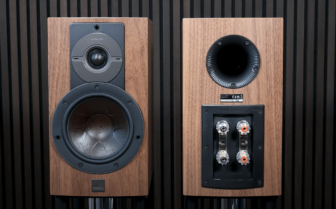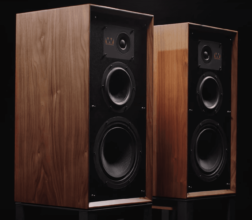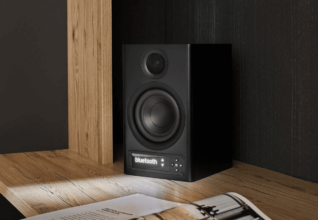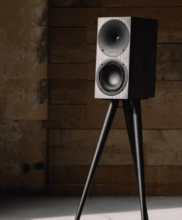Sonoro orchestra slim gen 2 review
Slender, clean design, not too expensive, and ready for audiophile challenges: Sonoro’s Orchestra Slim pursues several goals. The 2nd generation aims to further elevate the sound.
by Julian Holländer
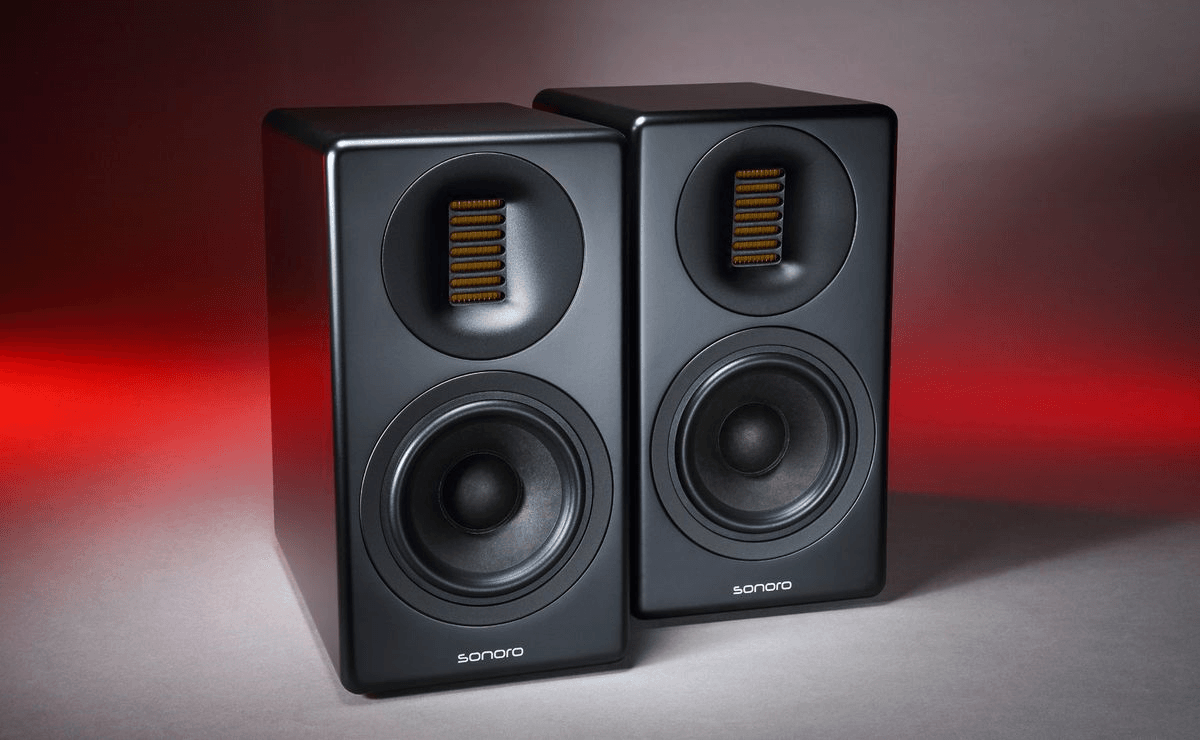
There’s no denying that Sonoro has firmly arrived in the hi-fi market. The company from Neuss hasn’t lost sight of its roots in stylish all-in-one systems, but for quite some time it has also offered an almost complete package of hi-fi gear, from turntables and amplifiers to loudspeakers, large and small.
They also remain committed to refining established products, consistently sharpening their concepts. After updates to systems like the Meisterstück all-in-one and the Maestro CD network receiver, the upgrade wave has now reached the elegant compact speakers Orchestra Slim, whose second generation we examine here in depth.
While the Orchestra Slim remains Sonoro’s smallest passive hi-fi loudspeaker, the brand is also moving upmarket. At “High End 2025,” the German company announced that loudspeaker design legend Karl-Heinz Fink had joined forces with them. The result is “Signature” versions of several components that sit above the existing lineup in quality and price—yet still aim to make “high-end” qualities more attainable.
So is a second generation of the relatively affordable Orchestra Slim really that exciting? We think so! Without taking anything away from those “high-end” ambitions, it’s always great to see how much quality can be offered for a more modest budget. Sure, just under $1,181 isn’t exactly pocket change for most people—that’s clear. But living-room-friendly design, fine workmanship, and of course high-quality sound can quickly justify such a price for music fans.
What’s different in the 2nd generation?
At first glance, you’ll have to look for the improvements. From the outside and visually, there’s not much to distinguish Gen 1 from Gen 2. Okay—the compact packaging and the well-printed manual reveal it in the name.
But optics don’t have to change for a product to improve—especially not at a company like Sonoro, which prizes appearance alongside hi-fi qualities and takes pride in its “German Audio Design.” That remains attractive and premium. The Orchestra ticks several boxes you don’t always see even on pricier speakers: elegantly rounded edges, completely magnetically attached grilles, and more. While the AMT tweeter lends the whole speaker a somewhat more technical look, the elegantly screw-less baffle balances that out.
Of course, it’s not just the design of the sturdy HDF cabinet that matters; the functional architecture has to be right, too. That’s exactly what the slightly backward-slanted front is meant to demonstrate. Because it’s angled and thus not parallel to the back panel, standing waves are reduced. This layout also plays a role in timing—ideally, sound waves should reach your ears as simultaneously as possible for fast, faithful transient response, which such a design can encourage.
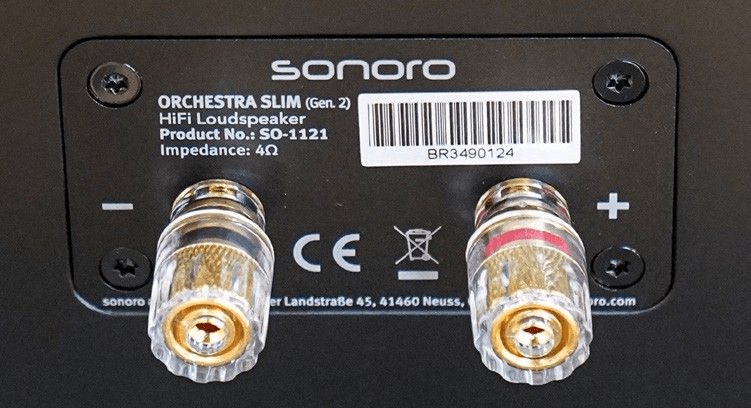
The single-wiring terminal on the back—anything more would be overkill here—is solid and easy to grip.
TEST EQUIPMENT
Streamer: Bluesound Node Integrated amplifier: Electric Audio TAE 150 DV
Streaming integrated amplifiers: WiiM Amp Ultra, T+A R2500 R, Eversolo Play
Loudspeakers: Sonoro Orchestra Gen 1, Sonoro Grand Orchestra, B&W 607 S2 Anniversary
Cables: Silent Wire
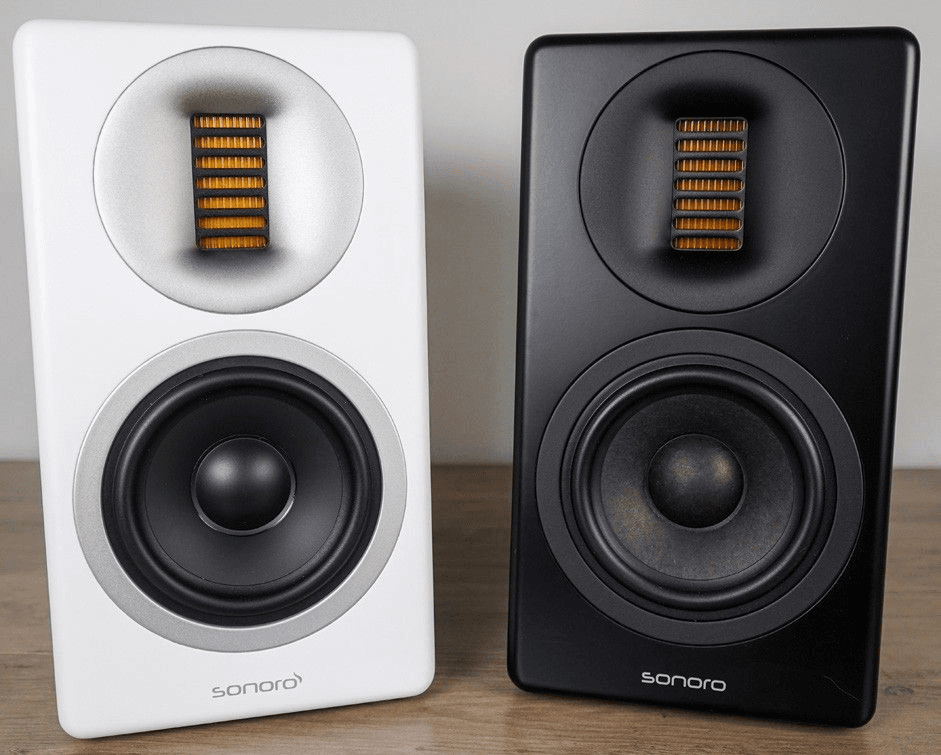
The visual differences between Gen. 1 (left) and 2 (right) are limited to the woofer diaphragm. Both generations are available in black and white.
On to the updates—and here there is a clear change: the completely new woofer. The predecessor used a coated paper cone; this one is more complex. To achieve the ever-desired combination of high stiffness and low weight, the new cone is a composite of paper and bamboo, additionally reinforced with Kevlar.
Cabinet and tweeter
To match this mid-bass driver, the cabinet volume was slightly adjusted (though not in a way that’s visible). Also out of sight are the damping for the woofer and a stabilizing brace located just behind its top edge. As in the first generation, there’s an Air Motion Transformer tweeter at the top with a folded area of around 85 cm², surrounded by a slightly horn-shaped waveguide.
To briefly reference our review of the first-generation Orchestra Slim: for all the praise of precision, timing, and charm—qualities shaped more by the mid and high frequencies and the evidently very good crossover tuning—the speakers played with a “rather slim foundation.”
That wasn’t a deal-breaker, but it showed the slim cabinet still had some potential in the low end—something that’s also grounded in physics. Despite all possible optimizations, a small enclosure and a 5.25-inch woofer simply can’t reach as deep as larger components.
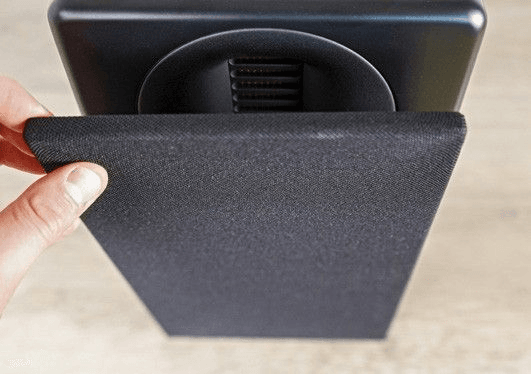
The grille attaches elegantly with magnets to the slightly slanted baffle.
More body and space
Given the same cone size and almost the same cabinet volume, it’s not exactly surprising: the Orchestra Slim Gen 2 isn’t a bass powerhouse with subwoofer-like depth—no one would expect that. However, the lower frequencies are tidier than in its predecessor, and the overall sound has more fullness.
It still doesn’t reach pricier and much larger floorstanders—our references included, among others, Sonoro’s own Grand Orchestra at more than twice the price, which play deeper and with more authority, thus sounding larger and broader—but for such compact dimensions, the result is good. The timing is excellent, too, which helps with transient impact.
While Gen 1 already delivered solid precision, the newcomer significantly improves on naturalness and coherence. Karajan’s Berlin Philharmonic performing the agitated “Mars” from Holst’s “The Planets” appears convincingly on a nicely opening stage; the orchestra sounds natural yet well defined.
Likewise in the gently psychedelic “Anemone” by The Brian Jonestown Massacre: the Orchestra Slim conveys the relaxed mood with ease, while the vocals sit charmingly within the mix with appropriate body and spatial depth—another noticeable improvement over the predecessor, which rendered things a bit flatter.
An arguably unexpected bonus of the Slim’s comparatively light low-bass (also due to size) is the option for relatively close wall placement. Positioned just in front of a wall (≤30 cm), the bass grows in level and presence. If it becomes stronger than desired, the supplied foam plugs can be inserted into the rear bass-reflex ports to counteract the effect.
A small and fine set-up?
On a sideboard or lowboard—perhaps paired with a compact streaming amp or a CD network receiver (Sonoro’s Maestro fits the bill)—you can quickly assemble an excellent stereo set-up that will fill small to medium rooms with natural, attractive sound. They’re not extremely power-hungry either; they reach healthy levels even with more affordable amplifiers, let alone with higher-quality or more powerful ones.

If bass is too strong with near-wall placement, the supplied plug helps.
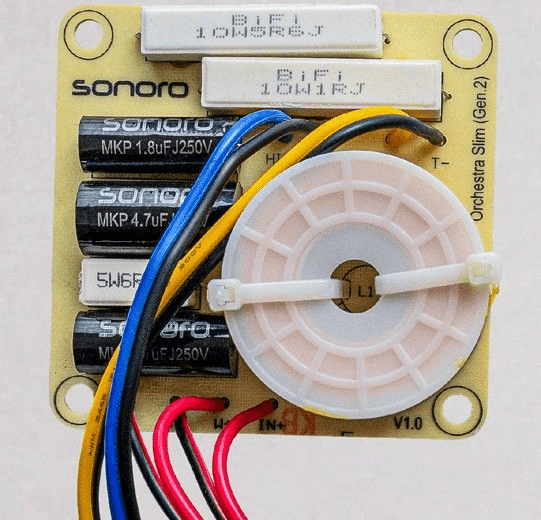
Compactly built, the crossover splits the drivers at 2,800 Hz.
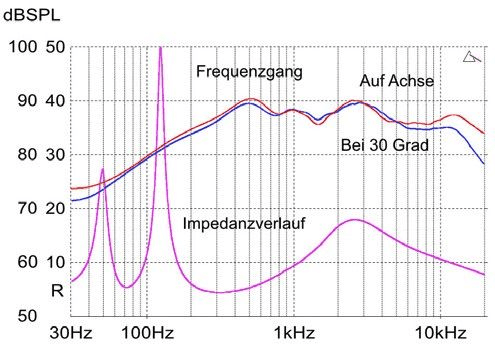
The frequency response doesn’t extend extremely deep, but is relatively clean above that.
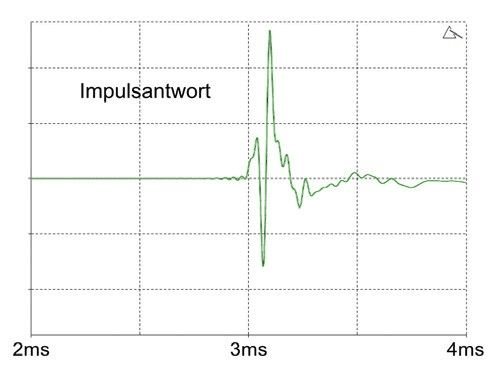
Despite a small amount of ringing, the Slim’s timing is good.
For placement on furniture, small rubber feet are conveniently attached to the undersides. If you want to follow hi-fi best practices and place the speakers more freely in the room—which yields more controlled bass at the expense of ultimate depth—you can of course use stands. Sonoro offers matching stands for $354 per pair; thanks to threaded inserts on the Orchestra undersides, they can be bolted on for extra stability. The stands also ensure the speakers sit at the optimal listening height, rather than too high or too low.
They deserve careful positioning—nothing complicated—to deliver a highly satisfying soundstage: form an equilateral triangle as described in the manual, choose a wall distance to taste for bass balance, toe-in slightly—and you’re set for a listening experience worthy of the musical name “Orchestra.” Not for huge rooms—where they also wouldn’t fit visually—but in smaller spaces the “Slim” brings lovely naturalness and precision as a clearly improved “Generation 2,” with suitable foundation, spaciousness, and body.
Product basics
Model: Sonoro Orchestra Slim Gen 2 (passive compact loudspeaker)
Price: €999 (≈ $1,180; rough conversion)
Website: www.sonoro.com
Dimensions (W × H × D): 18 × 32.6 × 26 cm
Weight: 6.5 kg (each)
Distributor (Germany): Sonoro — Tel.: +49 2131 8834141
Design: Dynamic, 2-way, bass-reflex; Terminal: single-wire
Placement advice: Slight toe-in; works free-standing or relatively close to a wall
Ratings
Sound (“KLANG”, 60% weight): Sehr gut 1.3 → 9.3/10
Sound quality note: Detailed and natural; not extremely deep, but with pleasing body and spaciousness.Measurements (“MESSWERTE”, 15% weight): Gut 2.4 → 6.9/10
Features & handling (“Ausstattung & Handhabung”, 25% weight): Befriedigend 2.7 → 6.2/10
Overall (“Endnote”): Gut 1.8 → 8.2/10
Measurement details
Frequency response: Satisfactory
Sensitivity (dB): Satisfactory (87 dB)
Impulse response: Good
Minimum impedance: 4.9 Ω @ 310 Hz
Distortion @ 63 Hz / 3 kHz / 10 kHz: Good (1.25% / 0.068% / 0.11%)
System matching: Good
Features & handling details
Setup/placement: Easy
Manual quality: Good
First power-up: Easy
Tone correction available: No
Finishes: Black, White
Included accessories: Grille, rubber feet, foam port plugs
Feel & build quality: Good
Upgradeable: No
Warranty: 5 years


